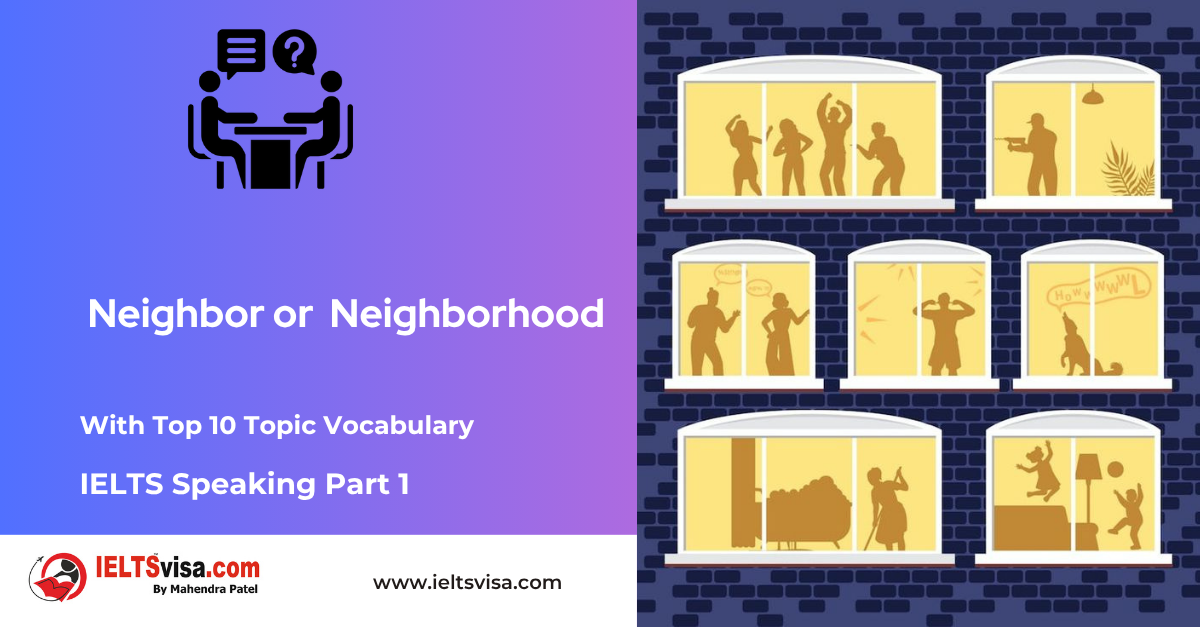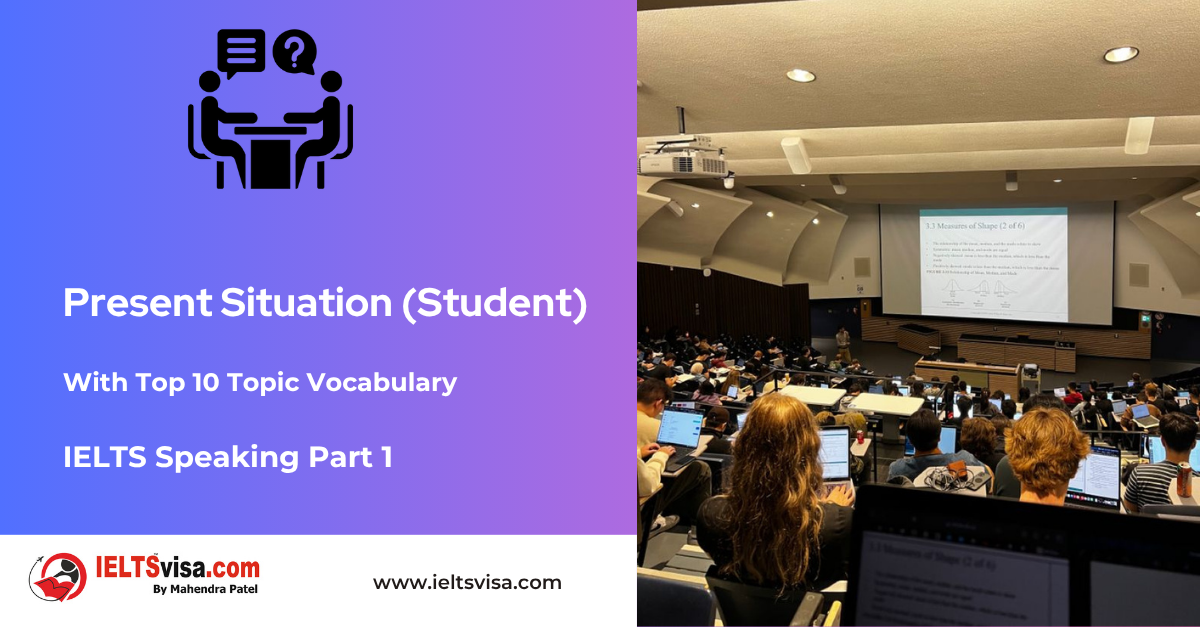IELTS Speaking Part 1 – Neighbours or Neighbourhood
IELTS Speaking Practice
IELTS Speaking Part 1 – Neighbours
or Neighbourhood
Examiner: Do you enjoy living in your current neighbourhood?
Candidate: Yes, I generally enjoy living in my current neighbourhood. It offers a good balance between peace and quiet, convenience, and access to amenities. There’s a sense of community, and I feel comfortable and safe in my surroundings.
Examiner: How well do you know your neighbours?
Candidate: I wouldn’t say I know them super well, but I’m familiar with some. I often see my next-door neighbours and exchange friendly greetings. We might chat about the weather for some neighbours or share recommendations for local services.
Examiner: Have you ever had any problems with your neighbours?
Candidate: Thankfully, no major problems! Minor inconveniences, like occasional noise from gatherings, can happen, but a polite conversation usually resolves them. Overall, my neighbours are considerate and respectful.
Examiner: What kind of neighbourhood would you ideally like to live in?
Candidate: My ideal neighbourhood would be walkable with plenty of green spaces, close to cultural attractions, and with a strong sense of community. Access to good schools, shops, and public transport would also be a plus.
Examiner: Do you think it’s important to have a good relationship with your neighbours?
Candidate: Having a good relationship with neighbours isn’t essential, but it can definitely enhance your living experience. Friendly neighbours can create a sense of security and belonging and might be helpful in unforeseen situations.
Examiner: Do you think neighbourhoods are becoming more or less close-knit these days?
Candidate: That’s a complex question! In some areas, busy lifestyles and changing demographics might lead to less interaction with neighbours. However, some communities actively promote neighbourly connections through events or social media groups.
Examiner: What are some benefits of living in a close-knit neighbourhood?
Candidate: Living in a close-knit neighbourhood can offer a strong sense of community and belonging. There might be a greater level of trust and willingness to help each other out. Children can benefit from safe play spaces and interaction with other kids.
Examiner: What are some challenges of living in a close-knit neighbourhood?
Candidate: There could be a sense of intrusion or lack of privacy, especially in very close quarters. Disagreements with neighbours can be more impactful in a close-knit community. Finding the balance between friendliness and respecting boundaries is vital.
Examiner: Do you think getting involved in your neighbourhood community is important?
Candidate: Getting involved can have benefits! Participating in local events, volunteering, or joining community groups can be a great way to meet neighbours, contribute to your surroundings, and create a stronger sense of belonging.
Examiner: How do you think technology has changed how we interact with our neighbours?
Candidate: Technology can be both a facilitator and a barrier. Neighbourhood social media groups or online platforms can connect people and share information. However, overreliance on technology might replace face-to-face interactions, potentially weakening the sense of a close-knit community.
Examiner: Have you ever lived in a neighbourhood that you didn’t like?
Candidate: Unfortunately, I once lived in a neighbourhood that wasn’t ideal. It lacked green spaces and amenities, which made it inconvenient for my daily needs. Additionally, frequent disturbances made it difficult to relax at home.
Examiner: Do you think feeling safe in your neighbourhood is important?
Candidate: Absolutely! Feeling safe and secure is crucial for a peaceful living environment. A safe neighbourhood makes you feel comfortable walking at night or leaving your home unattended.
Examiner: How do you think the design of a neighbourhood can impact the lives of its residents?
Candidate: Neighbourhood design plays a significant role! Walkable areas with green spaces encourage outdoor activities and a sense of community. Well-maintained streets and infrastructure contribute to a pleasant living environment. Conversely, poorly planned neighbourhoods can lack amenities, lead to traffic congestion, and create a sense of isolation.
Examiner: Do you think it’s important for neighbourhoods to have a mix of residential and commercial areas?
Candidate: A mix of residential and commercial areas can be very beneficial. It allows residents easy access to essential services like shops, restaurants, and cafes within walking distance. This creates a vibrant and convenient environment.
Examiner: Do you think governments should invest in improving neighbourhoods?
Candidate: Absolutely! Investing in neighbourhoods can have a positive ripple effect. Upgrading infrastructure, creating green spaces, and promoting community initiatives can significantly improve the quality of life for residents. Focusing on well-designed neighbourhoods fosters a sense of belonging and contributes to a thriving city overall.
Top 10 Topic Vocabulary for “Neighbours or Neighbourhood”
|
Vocabulary |
Type |
Meaning |
Synonyms |
Antonyms |
Word Family |
Example Sentences |
|
Community |
Noun |
A group of people living in the same place or having a particular characteristic in common |
Society, Neighborhood |
Isolation |
Communal (adj), Communicate (v) |
There is a strong sense of community in my neighbourhood. |
|
Amenity |
Noun |
A desirable or useful feature or facility of a building or place |
Facility, Convenience |
Disadvantage, Drawback |
Amenities (plural) |
Access to amenities like parks and shops is important for a good quality of life. |
|
Interaction |
Noun |
Reciprocal action or influence |
Communication, Contact |
Isolation, Separation |
Interact (v), Interactive (adj) |
Technology has changed the way we interact with our neighbours. |
|
Considerate |
Adjective |
Careful not to inconvenience or harm others |
Thoughtful, Kind |
Inconsiderate, Rude |
Consider (v), Consideration (n) |
My neighbours are very considerate and respectful. |
|
Infrastructure |
Noun |
The basic physical and organizational structures and facilities needed for the operation of a society |
Framework, Foundation |
Disrepair |
Infrastructural (adj) |
Good infrastructure is essential for a pleasant living environment. |
|
Close-knit |
Adjective |
(Of a group of people) united or bound together by strong relationships |
Tight-knit, United |
Distant, Unconnected |
Close (adj), Knit (v) |
Living in a close-knit neighbourhood offers a strong sense of belonging. |
|
Convenience |
Noun |
The state of being able to proceed with something without difficulty |
Ease, Comfort |
Inconvenience, Difficulty |
Convenient (adj), Conveniently (adv) |
The convenience of nearby shops makes this neighbourhood very appealing. |
|
Secure |
Adjective |
Free from danger or threat |
Safe, Protected |
Insecure, Unsafe |
Security (n), Securely (adv) |
Feeling secure in your neighbourhood is crucial for a peaceful living environment. |
|
Design |
Noun/Verb |
A plan or drawing produced to show the look and function of a building or object before it is made |
Plan, Blueprint |
Disorganization |
Designer (n), design (v) |
Neighbourhood design can impact residents’ quality of life. |
|
Interaction |
Noun |
Reciprocal action or influence |
Communication, Contact |
Isolation, Separation |
Interact (v), Interactive (adj) |
Technology has changed the way we interact with our neighbours. |

Our Books
Master IELTS Speaking Part 1
IELTS Writing Task 1 Book
IELTS Writing Task 2 Book
Practice IELTS Other Modules
IELTS Listening
The IELTS Listening test assesses how well you can understand spoken English in various contexts. It lasts about 30 minutes and is divided into four sections with a total of 40 questions. The listening tasks become increasingly difficult as the test progresses.
IELTS Academic Reading
The IELTS Academic Reading section assesses your ability to understand and interpret a variety of texts in academic settings. It is designed to evaluate a range of reading skills, including skimming for gist, reading for main ideas, reading for detail, understanding inferences, and recognizing a writer's opinions and arguments.
IELTS Speaking
The IELTS Speaking test assesses your ability to communicate in English on everyday topics. It lasts 11-14 minutes and consists of three parts: introduction, cue card, and a discussion based on the cue card topic.
IELTS General Reading
IELTS General Reading tests your ability to understand and interpret various types of texts. Here are some key areas and types of content you can expect to encounter in the reading section, along with tips for effective preparation.
IELTS Academic Writing Task 1
In IELTS Academic Writing Task 1, you are presented with a visual representation of information, such as graphs, charts, tables, or diagrams, and you are required to summarize, compare, or explain the data in your own words.
IELTS General Writing Task 1
In IELTS General Writing Task 1, you are required to write a letter based on a given situation. The letter can be formal, semi-formal, or informal, depending on the prompt. Here’s a breakdown of the key components to include in your letter
IELTS Academic Writing Task 2
In IELTS Academic Writing Task 2, you are required to write an essay in response to a question or topic. Here’s a guide to help you understand the essential elements of this task
IELTS Exam Tips
To succeed in the IELTS exam, practice regularly, familiarize yourself with the test format, improve your vocabulary, develop time management skills, and take mock tests to build confidence.
Grammer for IELTS
Grammar is the foundation of effective communication in English. Understanding tense usage, subject-verb agreement, and sentence structure enhances clarity and coherence in writing and speaking.
Vocabulary for IELTS
Vocabulary plays a crucial role in the IELTS (International English Language Testing System) exam, especially in the Speaking and Writing sections. Here’s an overview of why vocabulary is important and how it impacts your performance
RECENT IELTS SAMPLES QUESTIONS AND ANSWERS
IELTS Speaking Part 1 – Favourite Sujbect – Physics
IELTS Speaking Part 1 - Favourite Sujbect - Physics Q: What is your favourite subject? A: My favourite subject...
IELTS Speaking Part 1 – Present Situation (Student)
IELTS Speaking Part 1 - Present Situation (Student) Q1: Are you a student or do you work?A: I’m a full-time...
IELTS Speaking Part 1 – Present Situation – Employee – as an International Student and Social Worker
IELTS Speaking Part 1 - Present Situation - Employee - as an International Student and Social Worker Q1: Are...
IELTS Speaking Part 1 – Persent Situation – Employee- as an Electric Engineer
IELTS Speaking Part 1 - Persent Situation - Employee- as an Electric Engineer Q1: What do you do for a...
IELTS Speaking Part 1 – Persent Situation – Employee – as an Software Engineer
IELTS Speaking Part 1 - Persent Situation - Employee - as an Software Engineer Q1: What do you do for a...
IELTS Speaking Part 1 – Persent Situation – Married
IELTS Speaking Part 1 - Persent Situation - Married Q1: Are you married?A: Yes, I am married. My spouse and I...













